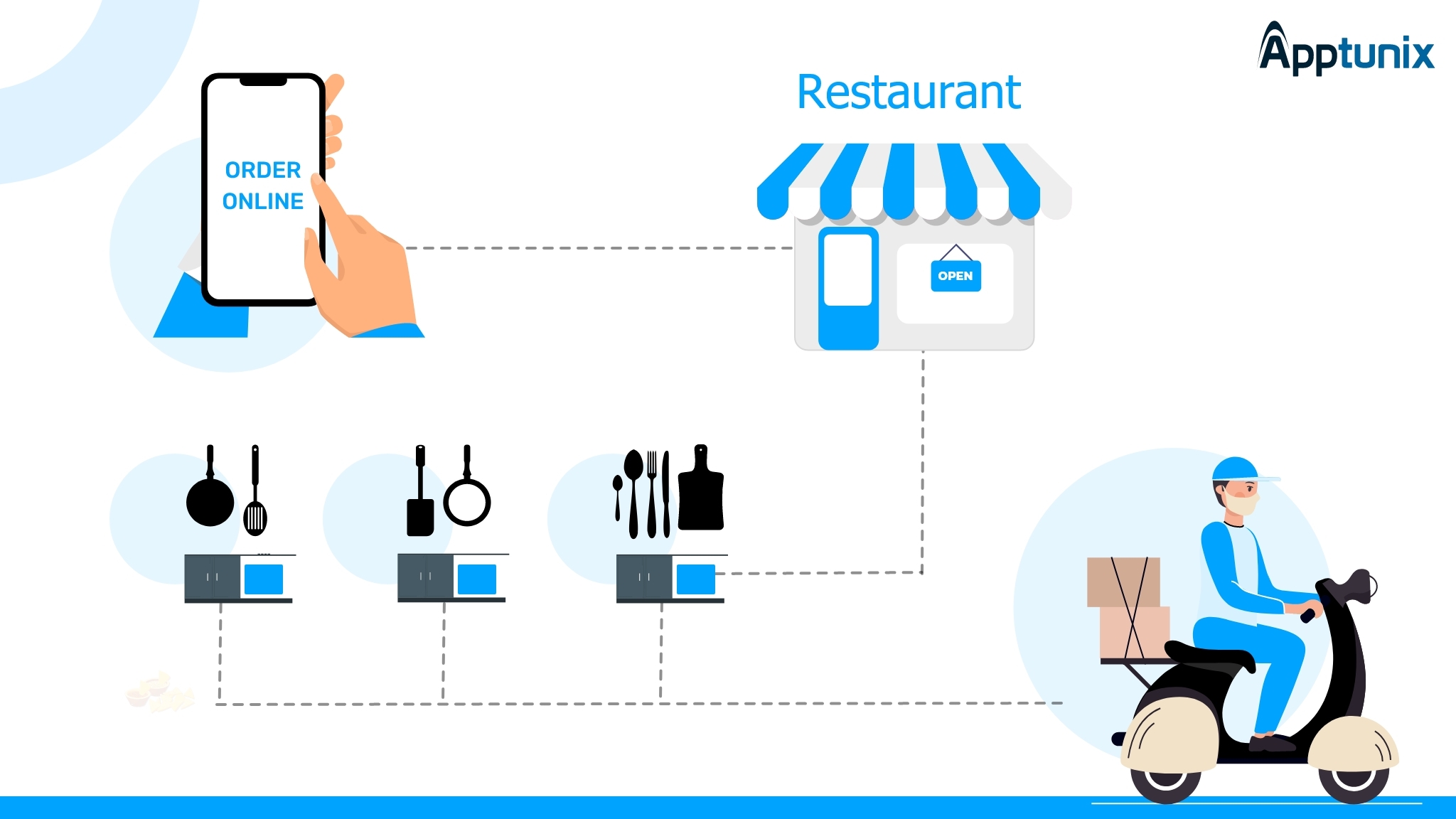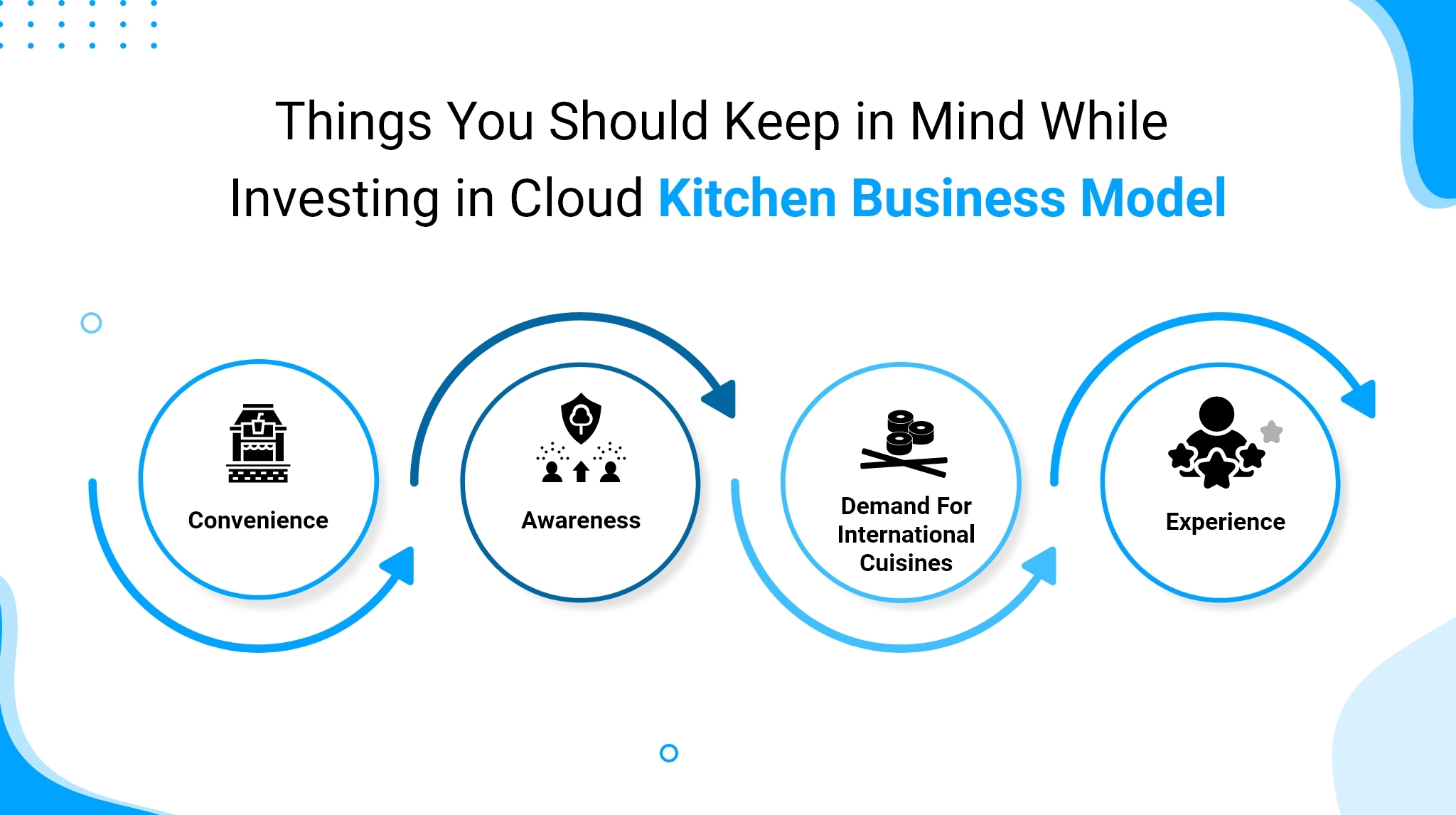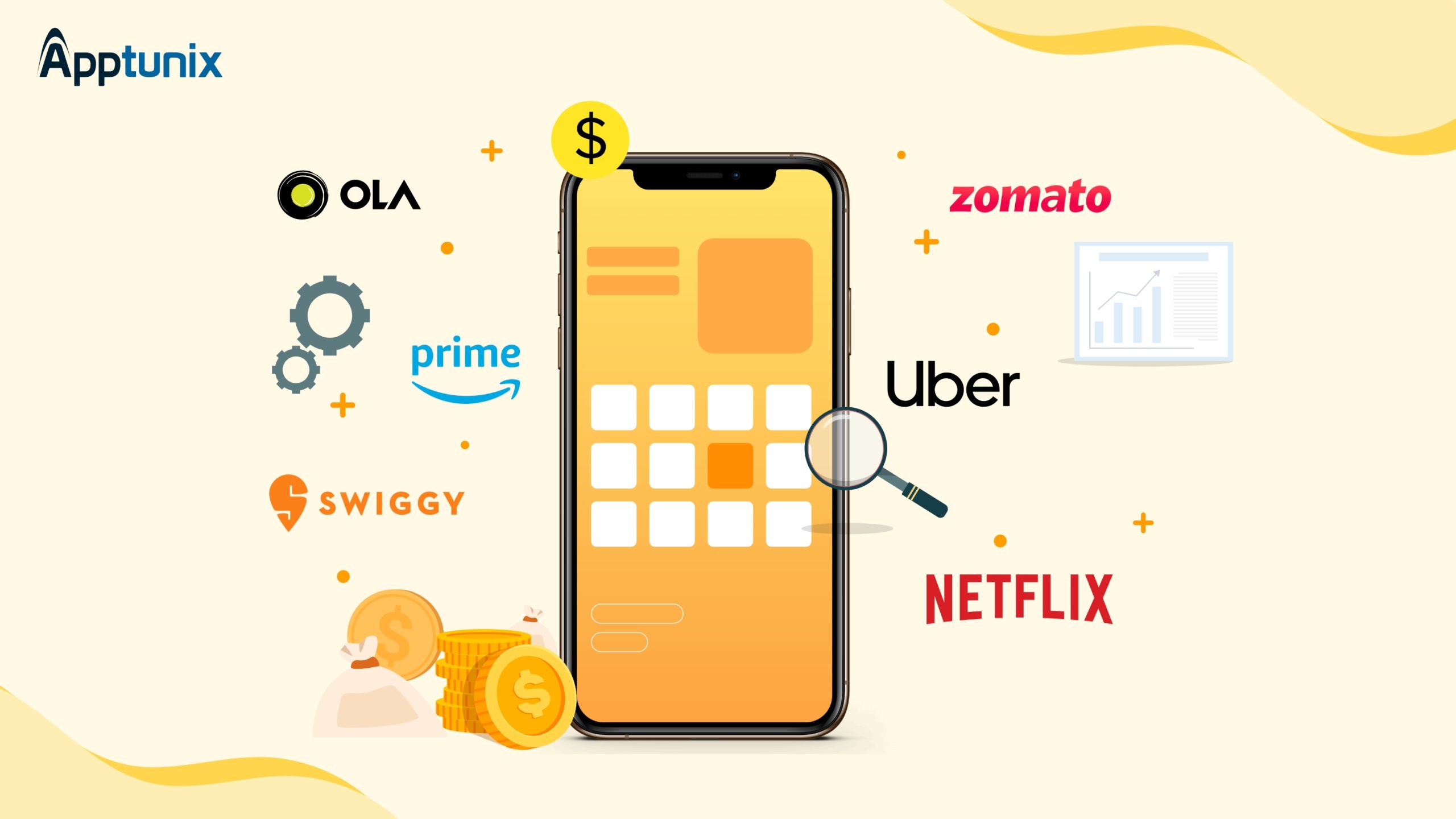Don't miss the chance to work with top 1% of developers.
Sign Up Now and Get FREE CTO-level Consultation.
Confused about your business model?
Request a FREE Business Plan.
Why Does Your Restaurant Need A Cloud Kitchen Business Model?
Table of contents

The exponential growth of the food delivery industry demands a cloud kitchen business model. In this blog, you will get to know about various cloud kitchen business models and how you can upgrade your restaurant with one.
The food delivery industry is expected to generate a revenue of $137,596 million globally by 2023. Imagine having a restaurant with an excellent model to capture this market. Sounds great right!
We are equipped with the facility that we can order food whenever we want in a few taps, right from our phones. Various restaurants you visit are collaborating with online food delivery platforms to grow their customer base. 67% of the restaurant owners are planning to open a cloud kitchen as their new outlet.
With the increasing popularity of the cloud kitchen business model, it is impossible to control the increasing number of restaurants demanding this. Read our blog further to find out how you can upgrade your restaurant with this business model.
What Is A Cloud Kitchen Business Model?
Cloud kitchens, also are known as ghost kitchens, virtual kitchens or shared kitchens are gaining so much popularity today. Cloud kitchen is a place where orders come, food is prepared, packed and then sent to the respective delivery locations.
Delivery optimization is not a new concept in the food industry. It is, in fact, the cornerstone of the pizza industry’s success storey. However, as consumers turn to on demand meal delivery rather than visiting restaurants, the delivery-only model has begun to gain traction. Technology, along with customer behaviour, is a significant driving reason behind the success of the cloud kitchen concept.
Before diving into the benefits and other subjects of the cloud kitchen business model, let me tell you how these work.
A cloud kitchen is a licenced commercial food production facility where a few to a dozen businesses may rent space to prepare delivery-specific menu items. A cloud kitchen can be based on one of two models:
- A single restaurant that operates numerous virtual eateries
- Various purveyors renting and operating from a single location
The cloud kitchen concept is extremely adaptable and varies depending on the size of the organisation.
Benefits Of Getting A Cloud Kitchen Business Model
The demand and growth of the cloud kitchen business model was a mere shock to many restaurants. Because costs of front house activities were reduced and people could focus on food. There are a lot of benefits of this model, like:
Low Real Estate Costs
The plan is to avoid table servicing and offer delivery-only service. This is going to save a lot of real estate costs.
Cloud kitchens relieve you of the requirement to have a place in a high-traffic location. Rather than paying for convenience, better-developed buildings, or even a huge parking space; you will be able to focus on having adequate kitchen space in a reasonable neighbourhood close to your target market.
More Expansion Opportunities
The most advantageous thing about cloud kitchen is that it does not require heavy investments. It is better to start small and then expand. Once you’ve established a brand and gained devoted consumers, expanding to additional locations and even menu diversity becomes easy.
No Overhead Costs
A cloud kitchen business model allows you to save overhead costs. You do not require client-facing employees, decorating, or a space entry, a parking lot, and so forth. Even if you have lower-priced menu items, your profit margins will almost certainly be higher.

Why Should You Invest In Cloud Kitchen Business Model?
Getting a space for your restaurant is a very difficult task. There are a lot of things that come in your way like the space is too small, or too costly.
Not only that, but a cloud kitchen can quickly alter the sort of cuisine they produce by hiring the proper chef and changing the menu online, requiring far less expenditure than a traditional restaurant, which must change everything from the concept of the restaurant to the marketing approach.
The main question that arises is should an existing restaurant consider investing in a cloud kitchen business model?
The answer is YES. This model will give far better exposure to your restaurant. The cost breakup is as follows:
Kitchen Space
Depending on how large you want your kitchen to be, anything between 800 and 1200 square feet would be ideal. This space would be more expensive in a prime location, but it would be less expensive in a non-prime location.
Kitchen Equipment
To make the cooking process easier in any cloud kitchen or kitchen, investing in sturdy kitchen equipment is a necessity. These items would consume the majority of your budget. If you want to spend less money here, buying secondhand equipment is a smart option.
Kitchen Staff
Hiring the greatest personnel should not be a compromise because the top chefs and efficient employees are the driving force behind the kitchen.
Other Expenses
Other expenditures include a POS system to control your spending, the 25-30% per order fee charged by online food ordering portals, restaurant licences and permissions, and food packaging fees.
6 Cloud Kitchen Business Models
There are a lot of variations of a cloud kitchen business model. You must implement the one that is suitable for your business. Some of the best business models for a cloud kitchen are explained below:

Independent Cloud Kitchen Business Model
This is the original and basic cloud kitchen business model. This contains a restaurant with no physical store or seating space. Restaurant operators or newcomers to the food industry might avoid exorbitant rents and real estate expenditures by outsourcing the front-of-house. This notion grew in popularity as internet ordering and customer demand for delivery increased.
Multi-Brand Cloud Kitchen Business Model (Faasos)
The most sophisticated cloud kitchens are based on data information, such as resident demographics, popular cuisines, and hyperlocal demand supply. The aim is to meet the need for the most ordered food in a neighbourhood (a 5-6 km radius) with relatively few restaurant alternatives serving these meals.
This strategy is brilliant since it portrays the different brands as independent entities. Furthermore, having a single common kitchen reduces operational costs. This approach is similar to the original cloud kitchen idea in that there is no actual storefront, for example, Faasos.
Hybrid Cloud Kitchen Business Model (Freshmenu)
This is a cross between a takeout restaurant and a cloud kitchen. For the most part, it is similar to a cloud kitchen business concept, but it also features a storefront. The storefront exists so that consumers may come in and watch how their food is made if they so choose.
In essence, this approach employs all of the operational advantages of the cloud kitchen business model while still providing a “real” window with consumers just like in Freshmenu.
Shell Cloud Kitchen Business Model (Swiggy)
This cloud kitchen architecture, known in the food industry as the “shell,” is essentially a perfectly situated vacant cooking area with the absolute minimum equipment – gas pipes, drainage, and ventilation systems.
Established (or new) restaurant businesses rent that cooking space and build up a restaurant using Swiggy’s online ordering, delivery fleet, and menu intelligence. The restaurant supplies the equipment, personnel, raw ingredients, and recipes. Simply put, the restaurant prepares the food and Swiggy delivers it.
Fully Stacked Cloud Kitchen Business Model (Zomato)
The Zomato model, which is an improvement on the bare bones Swiggy access approach, is based on the concept of rental kitchens but with built-in cooking equipment and extensive processes. Zomato also offers its expertise in order demand management in this manner.
These cloud kitchens, like the Freshmenu concept, feature a storefront where consumers may come in. Similar to the Freshmenu example, a mash-up of a cloud kitchen and a takeout restaurant.
Also, read about the excellent business model of Zomato
Fully Outsourced Cloud Kitchen Business Model (Kitopi)
This is a more recent addition to the cloud kitchen business model mix. You may outsource everything in this approach, including your contact centre operations, cuisine, and deliveries. Consider a restaurant where the vast bulk of the culinary preparation is outsourced and delivered to your kitchen.
Your cooks may then put the finishing touches on it before Kitopi picks it up for another delivery.
Everything You Must Know Before Building A Cloud Kitchen Business Model
Online on demand food delivery services has taken over the market today. A cloud kitchen business model is just like a cherry on the cake. There are some things you must take into consideration before implementing this business model in your restaurant:

Convenience
Going out to eat or cooking at home is becoming less enticing to millennials. Convenience is a major motivator in their decisions. Food delivery provides convenience, additional alternatives, and an increasing number of healthful selections.
Awareness
The younger generation is more inquisitive and observant of their surroundings. They seek answers to questions such as where their food comes from, how many calories it contains, and whether it is organic or not. Brands must develop and coordinate their marketing for this level of awareness.
Demand For International Dishes
They are eager to try new things. Whether it’s via international cuisines or fusions of various foods. Millennials are crazy about Korean Tacos, Ramen Burgers, and Butter Chicken Dosas.
Expertise
Experience is still quite valuable to these generations. However, it becomes difficult for restaurants to regulate it while performing the delivery. So, to improve your delivery experience, packing, and feedback discussions, pay more attention to those.
Over To You
The cost of establishing an on-demand food delivery app is determined by a variety of criteria such as sophisticated features incorporated, platform compatibility, development hours, development team location, and so on. The real development cost might range between $5,000 and $10,000.
A cost-effective alternative is to employ Apptunix ready-to-use solutions. The solution has the advantages of customizability, sophisticated functionality, and affordable cost.

Rate this article!
(1 ratings, average: 5.00 out of 5)
Join 60,000+ Subscribers
Get the weekly updates on the newest brand stories, business models and technology right in your inbox.

Lively and spirited. You may call me a tech-geek. I like to explore latest advancements in the technical areas and develop case studies. Being a computer science graduate, I like to traverse through the technical platforms as well. You can find me understanding or playing with the latest technology.

Telemedicine 2.0 - A Comprehensive Guide On What Healthcare Providers Need To Know?
Discover how the latest advancements like Artificial Intelligence in telemedicine are reshaping patient care. This comprehensive resource offers insights into the key trends and innovations driving this shift, providing valuable knowledge for healthcare professionals looking to stay ahead.
Download Now!

















